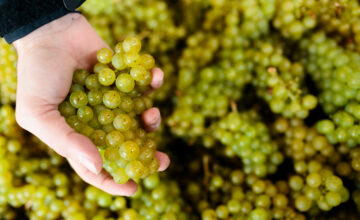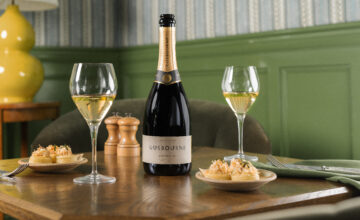Discover English Sparkling: tips and advice from Laura Rhys, Master Sommelier
One of the many glorious things about wine is that you need know nothing about it to enjoy it. Pop, fizz, clink, sip, sigh – simple. Your appreciation can stop there. But if you’re inclined to explore a little further, then learning about wine is unbelievably rewarding. The more you discover, the more potential for pleasure there is in every glass. England is an incredible wine region to delve into – not least because the wine industry here has the enormous benefit of being young. Even Gusbourne – which is one of the most established producers in the market – is still less than two decades old. This means English producers have come of age knowing that making themselves accessible to customers is essential for success. Wine lovers don’t need to untangle centuries of obscure traditions, conventions or complex processes to get to taste brilliant wine. There are no pretentions to navigate. It also means that the producers are still acquiring knowledge. The learning curve may have flattened since the first vines were planted, but with every vintage that goes by, they’re refining their ideas about our soils, our microclimates, our vines and varietals – and so on. As a wine lover, you get to come on this journey of discovery too. Exciting, right?
But, aside from the bigger picture, where should you actually start with English wine? Which is the first bottle you should try? And how should you approach it compared with champagne or prosecco? Laura Rhys MS, our partner Gusbourne’s Global Ambassador, has these tips.
1. Champagne is a useful reference point for tasting English sparkling.
“At Gusbourne, we use the same grapes as champagne for our sparkling wine (Chardonnay, Pinot Noir and Pinot Meunier),” says Laura. “And we make our wines in a way that’s inspired by vintage champagne production. The wines are complex and aged on their lees. Stylistically, we’re much closer to champagne than, say, Prosecco. But because we’re English, we’re also distinctly different.”

2. Gusbourne’s blend is Sussex chalk meets Kent clay.
The location of our vineyards is incredibly important. “In Kent, the soils are clay and sand,” says Laura. “This brings intensity and concentration to the grapes. Then we have our Sussex vineyards, which are chalk, flint, loam, sand and a little bit of clay. These wines have much more freshness and structure and heightened acidity. When you bring the two together, you get weight, ripeness, concentration, freshness and elegance. It’s why blending is so important. It’s what elevates Gusbourne wines.”

3. You can taste the way our wines are aged if you know what to look for.
We age our sparkling wines on their lees – the spent yeast. This sounds rather unappealing, but it’s important for flavour development. “Because of the length of time we age our wines, they have what we call ‘autolytic notes,’” explains Laura. “So, you might expect flavours of fresh brioche or toasted nuts. The lees-ageing also helps to increase the complexity of the wine. At Gusbourne, we have a balance of ripeness and freshness.”

4. Keep it cool, not cold
“I know a lot of people who love ice-cold sparkling wine and there’s nothing wrong with that,” says Laura. “But if you want to get the most from your wine in terms of the flavour profile and the structure, then I would serve it a little bit warmer.” As a rule of thumb, chill it to fridge cold, and then let it come-to out of the fridge for 10 to 20 minutes before serving.

5. Flutes are good, but wine glasses are even better
Champagne flutes are great in their own way. They hold the fizz. But, for fine sparkling wine, opt for a wider glass. “A tulip-shaped or white wine glass would be perfect,” says Laura. “It aerates the wine and delivers more of those flavours to your nose and onto your palate.”

6. Gusbourne Brut Reserve is a great place to start
“Brut Reserve is deliciously easy to enjoy and it’s a great introduction to the quality of English wine,” says Laura. “It has a soft, round fruit character. There’s freshness and elegance from Chardonnay, weight and roundness from the red grapes and lovely autolytic notes such as toasted brioche. With food, it’s wonderful with lemon and herb roast chicken, fish or seafood.” You can also enjoy it as an aperitif.

7. There’s more to Rosé than meets the eye
You’ll find the flavours of Gusbourne Rosé remind you of strawberries, raspberries and cherries. But you don’t need a summer’s day to open a bottle: “It’s delicious with lots of earthy flavours such as smoked duck and beetroot,” says Laura. “And, as it starts to age, it develops a beautiful savoury character from the Pinot, along with spices, ginger and orange zest.”

8. Take time to savour Chardonnay
Our Blanc de Blancs, a wine made just from Chardonnay grapes, is a beautiful expression of the quality of fruit that comes from our vineyards. “It has a pure, very elegant fruit character,” says Laura. “Think green apple, citrus fruit, blanched almonds. As it starts to age, that complexity builds. The fruit character softens; new flavours of toasted nuts and biscuit emerge.” Oysters are a classic match. “Or what about fish and chips? Blanc de Blancs is a perfect foil to the fat,” says Laura.

9. Sniff like a somm
The approach to tasting English wine is universal. First swirl the wine and take a few sniffs. “Often, you’ll pick up fruit characteristics before anything else. See what you can identify – it might not be totally specific, but is it a citrus smell, or ripe and tropical? Think about families of flavours. Sometimes you can smell something really familiar, but you can’t quite put your finger on it. That’s OK. At home, work on building your smell memory – try and focus on different smells in everyday life.” After you’ve identified the fruit flavours, then concentrate again and see if there are any more complex flavours. “Think about toasty flavours, spices and – in older wines – anything more ‘tertiary’,” says Laura. “Biscuit, pastry, roasted nuts and mushrooms are classic tertiary smells.”

10. Go back to the glass
Every wine evolves in the glass as it’s exposed to air and changes temperature. “When you first pour a wine, you’ll often taste and smell those primary fruit aromas. Then, as the wine opens up, sit with the glass and chat with friends. Then return to the wine and smell it again and again. When you pour your second glass, it will taste slightly different to the first – you’ll notice it unfold and evolve as the evening goes on.”

Gusbourne is the most awarded English wine producer. If you’d like to find out more about them, see here. Hoteliers interested in working with Gusbourne can contact Simon at simon.bradbury@gusbourne.com.


